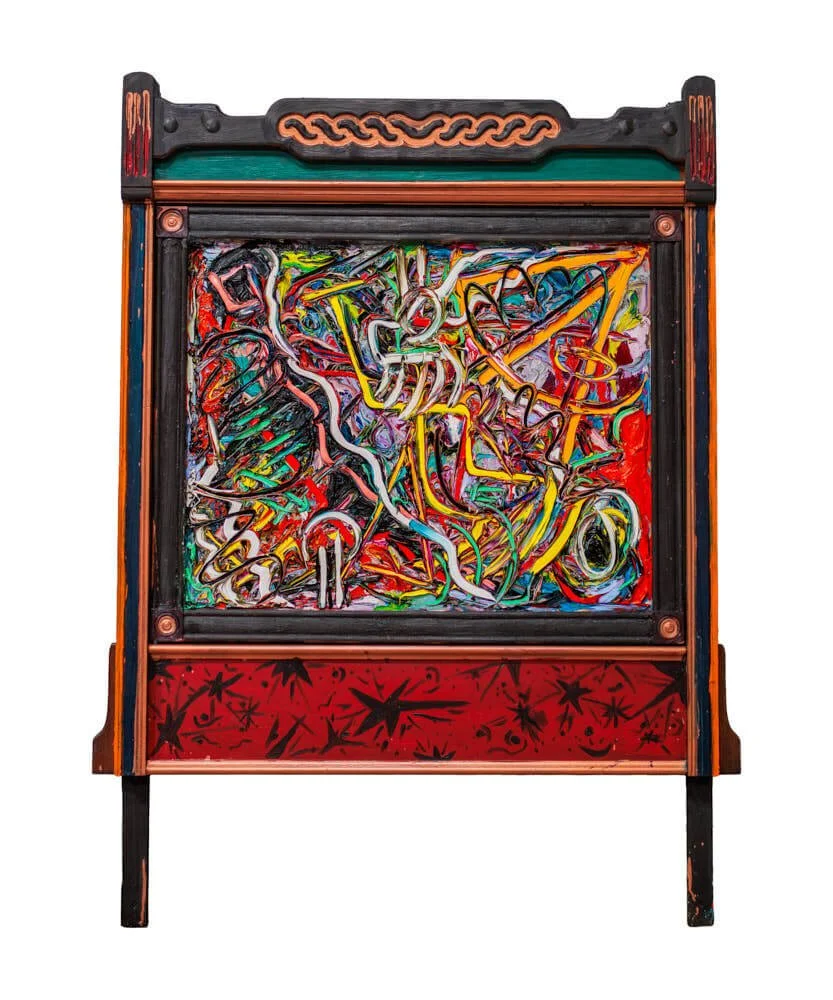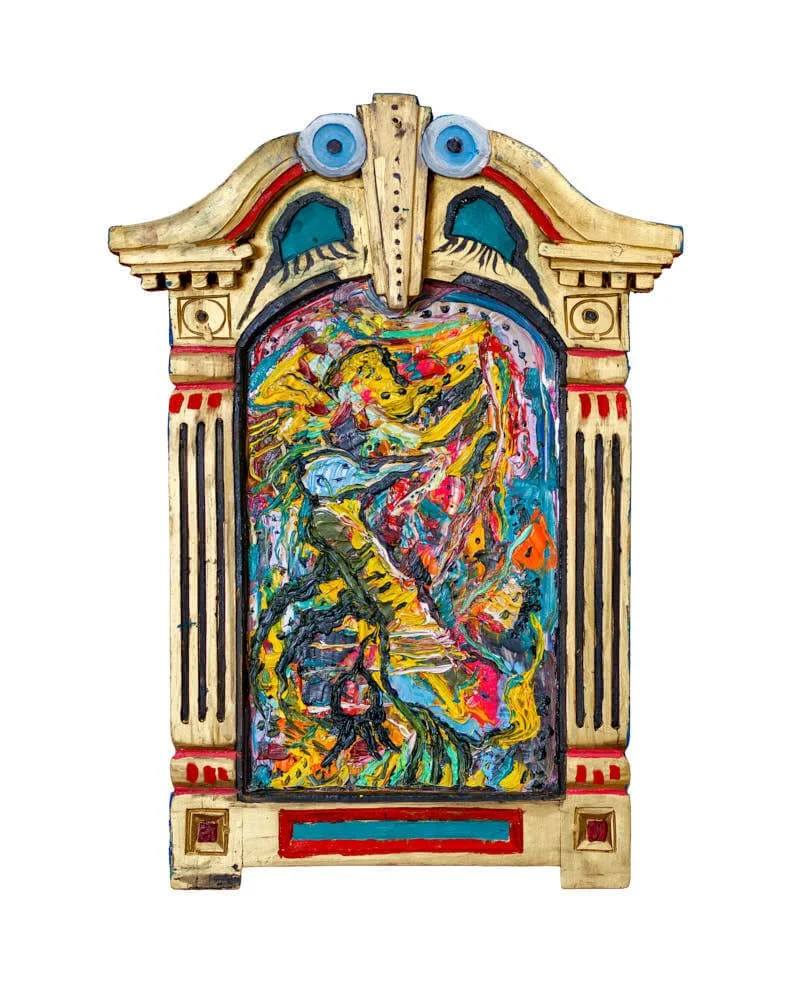GORDON MASSMAN
*The Single-Hearted Octopus
written + interview KATE HOAG
Gordon Massman is a Massachusetts-based poet and self-taught painter known for works too big for doorways, or polite living rooms—what he calls “shameless confessions of the human psyche.”
Drawing from Abstract Expressionism, confessional poetry, and Beat Generation literature, Massman creates works that balance deep psychological tension with a sharp wit.
Whether referencing myth, religion, or raw emotion, his work is guided entirely by instinct—part catharsis, part confrontation, and always unfiltered truth. In this conversation with LE MILE, Massman opens up about what it means to paint like Kodiak bear, seeing art as a single-hearted force, and using each brushstroke to expose the self and universal truths.
Gordon Massman
Cabinet of the Soul
Courtesy of the artist
Kate Hoag
You’ve said you “paint like a Kodiak bear attacking fresh carrion.” What does that look like in practice?
Gordon Massman
I paint with my stomach to survive. I squeeze colorful fingernails from tubes with which I slash the canvas. The meat tears in ragged lines which I have no interest in aesthetically purifying. My “skill” lies in rawness, imperfection, dominance—one might call it “un-skill.” In practice I fill my studio with grunts, curses, degradations; I break nails; I cry; I jubilate; I reject civility. At best my paintings resemble something savagely torn rather than neatly sliced with a knife and fork on tablecloth and chinaware. Ugly, like life itself, with its jealousies, betrayals, fears, compulsions, cruelty, demands. Painting is the catharsis of materializing emotion.
Your canvases are often impractically large. How does using a vast amount of space help you express what you’re after?
Rage cannot flow through needlepoint brushes. Nor can passion. Both require smashed up bristles and brushes thick as shovel handles. Likewise, only canvases torn from mizzen masts can contain the reflection of psychological pain, physical lovemaking, deaths of children, war and genocide, guilt and shame, the horror of roadkill. These are my subjects and fastidiousness on preordained practical canvases cannot contain it. I paint neither for money nor living rooms nor average size doorways. I’ve said this before: “There’s the tube of paint, the canvas, and the sum-total of your life. That is all.” I purposely omit critics, audiences, appeasements, conventions. Art is solitary, selfish, and practiced without compromise in a cave.
Although many of your paintings are “abstractions without identifiable subjects” others reference religious histories, political realities, or myths. What goes into deciding your subject for each work?
When I approach a blank canvas, I am innocent—a newborn. The instant I mark it, and again mark it, and mark it yet again, I begin maturing from baby to boy to adolescent to scholar to man to bitten prophet. Within this process, from the white fog, the subject appears—two vague faces, a human ribcage, a peacock riding a bicycle. The physical manifestation of the subconscious dictates my subject which does not become knowable until before me it galvanizes. At that juncture, I become a strong-handed, purposeful storyteller. I never identified as a Rorschach abstractionist, but rather, at my best, as a guide through our collective subconscious wilderness.
Your work often contains deep psychological tension while also using humor and vibrancy. Why is that combination important to you?
I inherited a rarely expressed sense of humor from my mother. On her hospice deathbed in late April, she thanked God for sparing her from the torture of another southern Texas blast-furnace summer. She found the upside to her own extinction. Oftentimes, profundity occurs at the collision of opposites, when for example, fine dining runs contiguous with rampaging revulsion. I do not like peaceful representations devoid of cogitation and conflict. As an incorrigible analysand, I prefer art to blossom outward from the deepest psychological kernel imbued with the weight of revelation, and yes, perhaps humor.
You have noted that Abstract Expressionism, confessional poetry, and Beat Generation Literature all shape your practice. How do these seep into your paintings?
Ted Hughes’s 1970 volume of confessional poems, Crow, with its blunt statements on love, greed, God, instinct, and survival released me to myself. For the first time this naive conformist realized the power of visceral truth, of taboo celebrated. It took two decades and an emotional crisis for me to enter this sacred realm of exquisite turmoil in the deepest regions of the mind and heart. I excavated obsessively and still excavate. Likewise, Jackson Pollock opened my mind to dictatorial urgency, damn tradition. These artists, along with many others, unlocked for me my very nature’s raging fire—independence, filthiness, brutality, courage, clarity of fact. This informs my best work.
Gordon Massman in atelier
seen Charles Carroll
“I paint with my stomach to survive.”
Gordon Massman speaks with Kate Hoag
for LE MILE .Digital
Gordon Massman
The Mad Draftsman’s Instruments
Courtesy of the artist
Gordon Massman
Apollo’s Little Cabinet of Distractions
Courtesy of the artist
You taught literature for years at The Massachusetts College of Liberal Arts and have written thousands of poems. Does being a poet influence how you paint?
I think of collective art as a single-hearted octopus residing in the gut with each appendage a genre—painting, sculpting, dancing, acting, writing, musical composition—one or two of which extrudes and writhes from the artist’s orifices. Artists are not the appendages but rather the life force of their octopus. Poetry is painting, painting is sculpting, sculpting is acting. It’s the life-furnace which creates, not the mode of expression. Every serious artist honors the fire, not the genre. For me poetry and painting are one in the same.
You often say your paintings are like “shameless confessions of the human psyche.” What are you confessing through your art?
The seven deadly sins, plus hilarity.
Your paintings have been described as having been unfolded in graphic, chaotic detail. Do you see the chaos in your paintings as a mirror of the world, or more of what’s happening internally?
I hypothesize that all living beings are one single organism nurtured by a worldwide interconnected subterranean root system of the psyche. As one being in that system, I strive to lay bare universal truths such as hunger, desire, insecurity, fear, self-hatred, megalomania, procreation, shame, and cruelty. I embody that, as does everyone but the godlike few. When successful, my paintings reflect simultaneously the world and myself, or, more aptly stated, the collective unconscious. I believe innumerable great paintings have been obliterated by overthinking.
Your new mirror works bring viewers inside the painting, literally and emotionally. What does the mirror mean to you in this new work?
I see my own brush meet itself when I paint a mirror, and my own hand clutching the brush, and my own posture, and my own expression. Gradually, I create upon my peaceful visage something strange and alien—a portrait-blob of my very subconscious, like a turbulent bog or science-fiction monster. I thrill at this decimation. I see myself unadulterated in the finished work. Finally, my inner being starkly stares back at me, who I am, what I am, what I am capable of, my conquest-fantasies. I may be hideous; I may be delectable. But finally, I am really me.
What’s next for you? And what else do you look forward to exploring in your work?
The future is unrevealed to me. I am the timeline of my own evolution. I can only perceive my present incarnation. Tomorrow, who knows. I could become a race car driver, an elephant whisperer, or the undertaker to my own death.
header Credit
Gordon Massman
Patriotic Fugue
Courtesy of the artist





